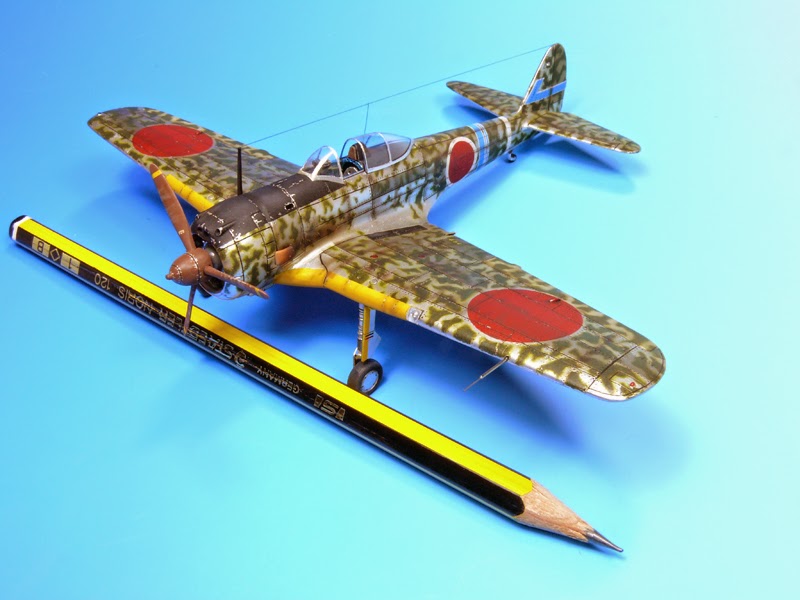The final model in José A Granado's splendidly plumed Hayabusa quartet is the III Ko, built from the Special Hobby kit with similar improvements to the others - enhanced cockpit interior, scratch-built headrest, detailed undercarriage, replacement engine, replacement canopy and metal tubing for the pitot. As with the others José riveted the entire airframe surface.
The model represents an aircraft of the 48th Sentai operating in China during the last years of the war and finished in the Tachikawa factory scheme of olive brown over grey. Previous blog posts on the subject of III Ko colours may be found here, here and here. The chosen finish on José's model harkens back to the original Tamiya 1/50th scale kit of 1964. The 48th was formed at Jiando, Manchuria in July 1943 from cadres supplied by the 77th Sentai and 204th Kyodo Hiko Sentai. It was equipped with the Ki-27 as it worked up to operational status, receiving Ki-43-II in January 1944 and undertaking its first combat sorties from Wuchang, China in April 1944 under the command of Maj Masao Matsuo. It began to equip with the III Ko from August 1944 and ended the war near Nanking. During its relatively brief combat history it claimed 55 enemy aircraft shot down and 40 damaged for the loss of 16 pilots. The lost pilots included three Hikotai leaders and three Chutai leaders.
According to Minoru Akimoto the Sentai emblem on the tail, which represented '48', was variously painted in white, red or yellow without this signifying the Chutai. In fact Dr Yasuho Izawa records the unit as only operating two Chutai and it has been suggested that white was the colour used for the 1st Chutai and yellow for the 2nd. Each aircraft was identified by a two-digit number painted on the rudder, probably representing the last two digits of the aircraft serial. The kanji characters 阿部 (a be) painted just behind the senchi hiyoshiki, the so called 'combat stripe' on the rear fuselage, represent the nickname of the pilot Sgt Shou Abe who flew in the 1st Chutai under Capt Koji Shimura.
These in-progress images show José's meticulous work and attention to detail. Basic 'office' improved with plastic card and wire.
Sidewall detail enhanced and carefully painted.
Instrument panel and engine painstakingly detailed.
The multiple exhaust ejectors drilled out and basic assembly prepared for painting.
As with the other models first a preparatory layer of gleaming aluminium, followed by pre-shaded grey.
Painting and pre-shading of the upper surface, with Hinomaru and yellow leading edge IFF strips added.
Lower surface Hinomaru painted on and weathering effects added.
The final result is superb. And the miniature Hayabusa is ready to complete the kettle of falcons.
With thanks to José for kindly sharing these images of his work and a beautiful collection. It has been a delight to see and show them.
Image credits: All © 2015 José A Granado





























































